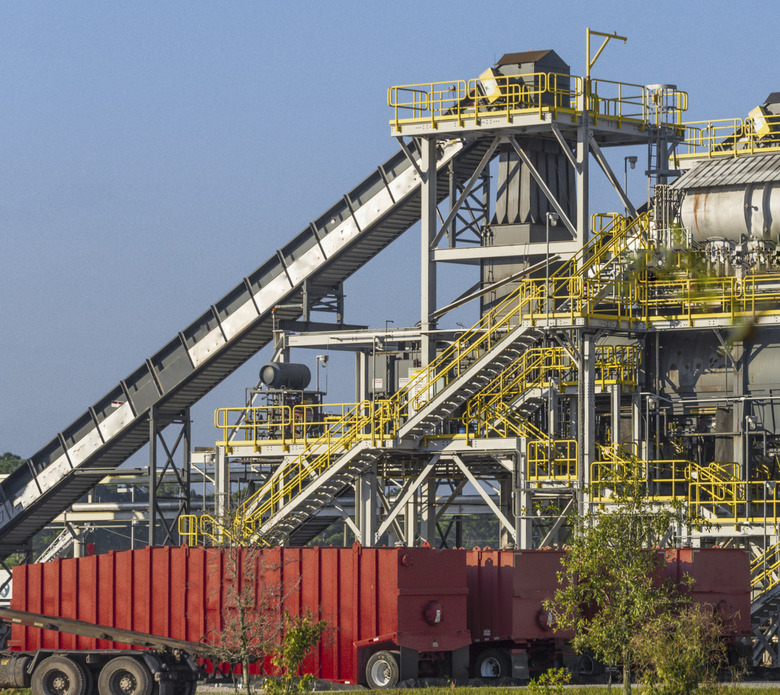Differences Between Biomass And Biofuel
People use biomass — organisms that are alive or that lived recently — to produce biofuel they can use for power. Biomass comes from feedstock such as vegetable oils, plants, grains and animal-based oils. Biofuel is important in a day when the U.S. imports about 50 percent of its petroleum supply from foreign countries. By converting biomass into biofuel and using that for energy, people can help the country become more energy independent and protect the environment.
Biomass Basics
Biomass Basics
When burned, biomass releases heat from its stored energy, along with carbon dioxide. Plants remove CO2 from the air when then undergo photosynthesis to create food. In addition to creating fuel for vehicles, you can also produce electricity by burning biomass. For instance, there are power plants that convert trash into enough electricity to supply 1.3 million homes in the United States.
Biofuel Benefits and Disadvantages
Biofuel Benefits and Disadvantages
Unlike fossil fuels, biofuels are renewable and could last indefinitely. Biofuels produced from biomass also have the potential to reduce pollutant emissions and greenhouse gas — problems that fossil fuels create. However, as the EPA notes, biofuels could produce more greenhouse gas than some fossil fuels on an "energy-equivalent" basis, depending on factors such as production method and feedstock type. Biofuels also often need subsidies and other types of market intervention to make them economically competitive with fossil fuels.
Biofuel: Power for Vehicles
Biofuel: Power for Vehicles
You'll find biodiesel or ethanol in most vehicles that use biofuels. Manufacturers convert animal fats and oils into biodiesel — a biodegradable, nontoxic replacement for regular diesel fuel. Fuel producers transform starch crops and sugar into bioalcohol fuels, such as butanol, propanol and ethanol.
Biodiesel Versus Regular Diesel
Biodiesel Versus Regular Diesel
Biodiesel burns cleaner than ordinary diesel fuel, produces fewer greenhouse gas emissions and helps keep engine parts from wearing prematurely. Because biodiesel is less combustible than petroleum, it's safer and doesn't cause as much damage if spilled. You can purchase different biodiesel blends that contain varying percentages of regular diesel and biodiesel. The B100 blend, for instance, consists of 100 percent biodiesel, while B20 only has 20 percent biodiesel. Fuels with higher blends produce less carbon dioxide emissions.
Behind the Scenes With Ethanol
Behind the Scenes With Ethanol
Henry Ford thought that ethanol would become the world's dominant fuel supply. Ethanol makes up over 95 percent of the gasoline in the United States. Most vehicles can run using a blend that contains 10 percent ethanol, while flexible fuel vehicles — which may also operate using gasoline — can use blends that contain up to 85 percent ethanol.
Ethanol Technology Breakthroughs
Ethanol Technology Breakthroughs
Non-food biomass sources, such as wood or grass, have the molecular compounds and other ingredients needed to produce cellulosic ethanol. This biofuel could reduce greenhouse gas emissions by over 80 percent. The nation opened its first commercial cellulosic ethanol plant September 3, 2014.
References
- U.S. Bureau of Labor Statistics: Careers in Biofuels
- United States Environmental Protection Agency: Economics of Biofuels
- U.S. Department of Energy Alternative Fuels Data Center: Biodiesel Fuel Basics
- U. S. Department of Energy www.fueleconomy.gov: Biodiesel
- United States Environmental Protection Agency: Basic Information | Biofuels
- U.S. Department of Energy Alternative Fuels Data Center: Biodiesel Benefits
- U.S. Department of Energy Alternative Fuels Data Center: Ethanol Fuel Basics
- Energy.gov: Four Cellulosic Ethanol Breakthroughs
- Energy.gov: Breakthrough in Bioenergy: American Process Sells First RIN-qualified Cellulosic Ethanol Shipment
- United States Environmental Protection Agency – A Student's Guide to Global Climate Change: Biomass Energy
Cite This Article
MLA
Lee, Kevin. "Differences Between Biomass And Biofuel" sciencing.com, https://www.sciencing.com/differences-between-biomass-biofuel-8010864/. 24 April 2017.
APA
Lee, Kevin. (2017, April 24). Differences Between Biomass And Biofuel. sciencing.com. Retrieved from https://www.sciencing.com/differences-between-biomass-biofuel-8010864/
Chicago
Lee, Kevin. Differences Between Biomass And Biofuel last modified March 24, 2022. https://www.sciencing.com/differences-between-biomass-biofuel-8010864/
